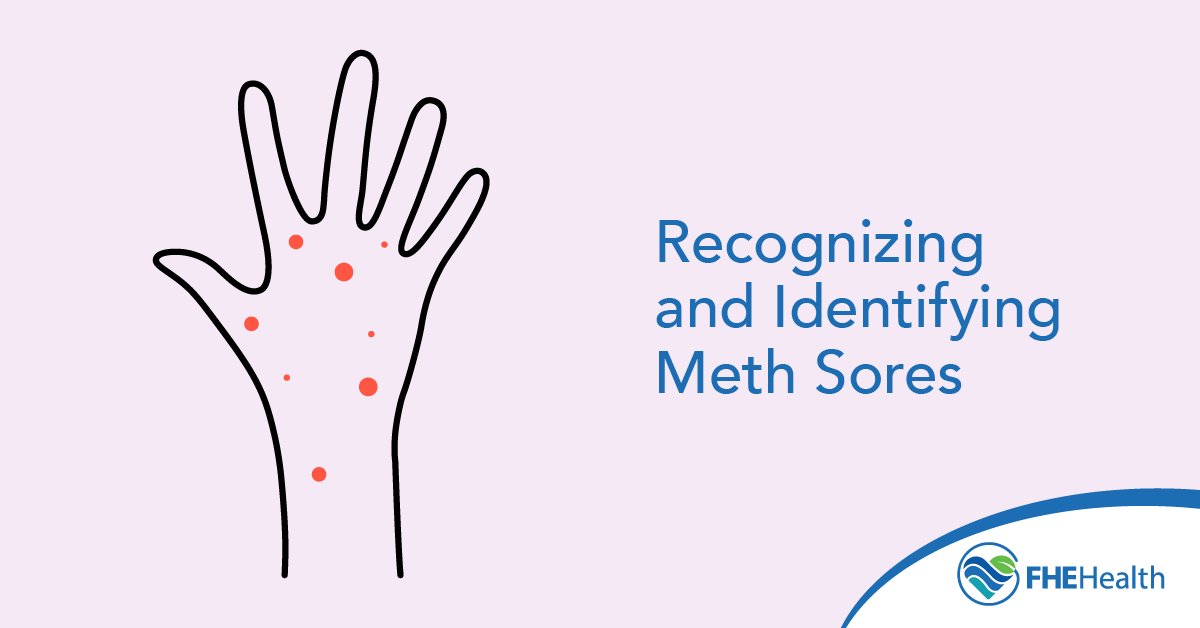
Meth use and related deaths have been increasing in recent years, underscoring the need to understand more about what the signs of addiction can look like and the physical and emotional toll meth use can take. One of the most visible signs of long-term meth use is meth sores. These sores are often present on the face, resulting in the common term “meth face,” but can also be present on other areas of the body.
Whether you’re dealing with a meth addiction or worry that someone you love is struggling with substance use, it’s important to recognize what symptoms like meth rash indicate and what it may mean for someone’s health.
What Meth Sores Are and Why They Occur
Meth sores are wounds that most often appear on the face and arms that are slow to heal and can become infected. They can be open wounds as well as scabbed-over sores that are attempting to heal.
Meth sores happen for a variety of reasons. One of the most common is related to the effect meth use has on the person’s sensory perception. Those that use meth often experience skin sensations that feel like a bug is crawling on or under their skin. This is referred to as formication and is a kind of tactile hallucination. Meth stimulates the central nervous system, which can lead to phantom crawling feelings. This can cause the person to scratch or pick at their skin repeatedly until sores form. Continuing to pick and scratch after the wound appears can interfere with healing. This is complicated by the fact that meth use in and of itself can slow wound healing because of the effect it has on reducing blood flow, which makes it harder for the body to heal itself.
Meth face can also be a result of an increase in cystic acne due to meth use, poor personal hygiene, and a compromised immune system. It’s also possible for someone to burn themselves while smoking meth, which can lead to open wounds on the face or other areas of the body.
Common Areas Affected and How to Spot Them
The term “meth face” is commonly used because of the high occurrence of meth sores on the face. Meth users may be more likely to pick at acne, which can increase the prevalence of facial wounds. The arms, legs, and torso may also have meth sores because the skin there is easily accessible for picking and scratching. You may notice more sores on the person’s nondominant side because it’s easier for them to access this area with their dominant hand. It’s also possible for sores to be present internally inside the mouth or on the inside of the lips. These sores can be aggravated by dry mouth, which is a common symptom of meth use. This can also lead to tooth decay and irritation to soft tissues like gums and the inside of the cheeks.
Meth sores look different depending on how long they have been present. New sores may look like small red bumps at first that can resemble a pimple or an insect bite. Once the person starts picking or scratching at it, the sore usually opens and may bleed, crust over, or exhibit signs of infection. If left untreated, sores can eventually get infected and turn into abscesses.
Health Risks Associated With Meth Sores
Meth sores aren’t just an aesthetic concern; they also have very real health risks. One of the most common is a bacterial infection getting into the wound. This may need to be treated with antibiotics, especially if there are more serious concerns such as a staph infection or cellulitis. Open wounds can also become entry points for more severe infections that can eventually result in sepsis or Methicillin-resistant Staphylococcus aureus (MRSA), especially in those with poor immune system function.
Someone who is presenting with meth sores may also have other health conditions, such as a weakened immune system or organ damage. In some cases, malnutrition can also be a factor in wound healing, which can cause more serious issues within the body.
Meth sores can also result in permanent scarring and skin damage, which can have a negative effect on the person’s mental health and self-esteem. Scarring is often present long after the person has sought treatment and gotten sober, and it may require specific treatments, such as chemical peels, to see an improvement in skin texture and tone. The psychological effect of living with visible scars can increase feelings of depression and anxiety and may result in the person withdrawing to avoid social situations.
Importance of Seeking Treatment for Meth Use
Meth rash generally happens after a person has been using meth for a significant amount of time, which makes it a visible warning sign that someone is struggling with substance use. If you have meth sores or you’ve noticed them on someone close to you, taking steps to address meth use and seek treatment can stop them from getting worse and improve healing — physically and emotionally.
In general, the earlier someone seeks help with substance use, the better the potential outcome. Early intervention can also help reduce the long-term risks associated with meth use, such as cognitive decline and organ failure. It can also decrease the chances of an overdose.
Many people avoid seeking help because they are ashamed of what they’ve done or believe that others will look down on them. However, recognizing that you need help to overcome addiction is the first step in healing. Trained health care providers can help you get sober and start addressing any underlying mental health issues that may have contributed to your addiction.
Healing and Recovery Options
Recovery after meth addiction is a multipronged approach that involves physical, emotional, and even relational healing. In most cases, the initial treatment involves a medically supervised detox process to help your body get rid of the substance while minimizing any adverse effects and keeping you stable. This step may also involve taking care of any open and infected wounds by cleaning and bandaging them. A doctor may prescribe an antibiotic, if necessary, to treat any active infections.
Once you’re through the initial physical detox, the focus often moves to helping you understand the factors that led to your addiction and coping skills to ensure you have the tools you need to stay sober. You may be able to choose whether you’d rather attend an inpatient program or an intensive outpatient program, depending on your needs and responsibilities. Both of these options generally include individual or group therapy and addressing any co-occurring mental health disorders.






